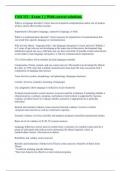CSD 333 - Exam 1 || With correct solutions.
What is a language disorder? correct answers Impaired comprehension and/or use of spoken,
written, and/or other symbol systems.
Impairment in Receptive language, expressive language, or both.
What is a communication disorder? correct answers an impairment of communication that
can result from speech, language or communication
Who are late talkers / language delay / late language emergence? correct answers Children 2
to 3 years of age who are not developing at the same rate as their peers, development lags
behind the typical rate (e.g., child does not say first word until 18 months or later) also known
as late talker or late language emergence; at risk for communication impairments.
51% of late talkers will eventually develop language normally
Components of form, content, and use correct answers This model was developed by Bloom
& Lahey in 1978. Says that a skilled communicator must learn the rules associated with 3
components of language that interact.
Form: Involves syntax, morphology, and phonology (language structure)
Content: Involves semantics (meaning of language)
Use: pragmatics (how language is utilized in social situations)
Evidence-based practice correct answers a process used for evaluation. Evaluating whether a
clinical practice, a strategy, program, curriculum or intervention is supported by rigorous
evidence of effectiveness or evaluate whether a practice is appropriate for a particular
individual
Internal and external evidence correct answers Internal evidence: involves a client's
viewpoint and concerns as well as a clinician's expertise.
External evidence: involves carefully and properly designed controlled experimental studies.
Basic levels of evidence (I, II, III, IV) correct answers
Language difference correct answers results from a variation of a symbol system used by a
group of individuals that reflects and is determined by shared regional, social, or
cultural/ethnic factors. Also known as dialect.
Reliability and validity correct answers
Benefits and limitations of Behaviorist Theory correct answers -Benefits of Behaviorist
Theory
" Useful for teaching specific behaviors
" Has been found to be effective in intervention programs.
, -Limitations of Behaviorist Theory
" Cannot explain how individuals spontaneously produce new, unique, and complex
behaviors, e.g., complex utterances produced by children- in the absence of reinforcement
techniques.
Clinical and educational applications of Behaviorist Theory correct answers " "Drill-and-
practice" activities.
" Encourage behaviors through shaping.
" Focus on small, separate skills (individual steps later integrated to comprise a more
elaborate language ability) e.g. a small separate skill: coloring, tracing a letter.
" Focus on behaviors that are "observable" and "measurable" e.g. In a behavioral way: when
working on receptive language, "the child will respond, react, point to, indicate" the child is
demonstrating knowledge / understanding.
Terminology related to Constructivist Theory correct answers " Schema- concept or mental
category (plural, schemata)
" Assimilation- Placing new information into existing schema
" Accommodation- Making modifications to schemata to allow for new information
" Equilibrium- Balance between assimilation and accommodation in order to create new
schemata.
" Disequilibrium- Once a child realizes that two schemata don't coincide, disequilibrum is
evidenced. This phenomenon allows for advances to higher thinking levels.
" Symbolic Play- When a child uses an unrelated object to represent another (e.g., a banana
used as a phone). e.g. Being able to use their imagination like using blocks to build a castle, a
building, a napkin to use as a blanket for a doll.
" Object Permanence- When a child realizes that an object is present even when it is out of
sight (during the sensorimotor period) e.g.
" Object Constancy- Realizing that an object is the same despite variations in physical
manifestation (e.g., distance, lighting, angle) e.g. an object in a container, its still the same
object, the same thing.
" Means-End- Demonstration of intentionality. The child carries out a plan to solve a problem
(e.g., pressing a button for a toy car to go down a ramp) e.g. does the child have good
cognitive skills? A child pressing a doll's belly to make it talk.
" Uses of Cognitive Theory- Children's play behavior is observed to assist in determining
their cognitive levels. We want to know are these bases, cognitive levels cover or do we have
to work on them.
" Limitations of Cognitive Theory- The assumption that children progress through specific,
sequential stages. All children do not follow this distinct order of development. Some
children solve difficult problems at earlier levels. People don't always go through these levels
in order or specifically.
Uses and limitations of Constructivist Theory correct answers " Uses of Cognitive Theory-
Children's play behavior is observed to assist in determining their cognitive levels. We want
to know are these bases, cognitive levels cover or do we have to work on them.
" Limitations of Cognitive Theory- The assumption that children progress through specific,
sequential stages. All children do not follow this distinct order of development. Some
children solve difficult problems at earlier levels. People don't always go through these levels
in order or specifically.




